Cold Chain Logistics: Management Challenges & Solutions
The supply chain is a term used to describe all the components required to transport goods from beginning to end, from production to the end...
9 min read
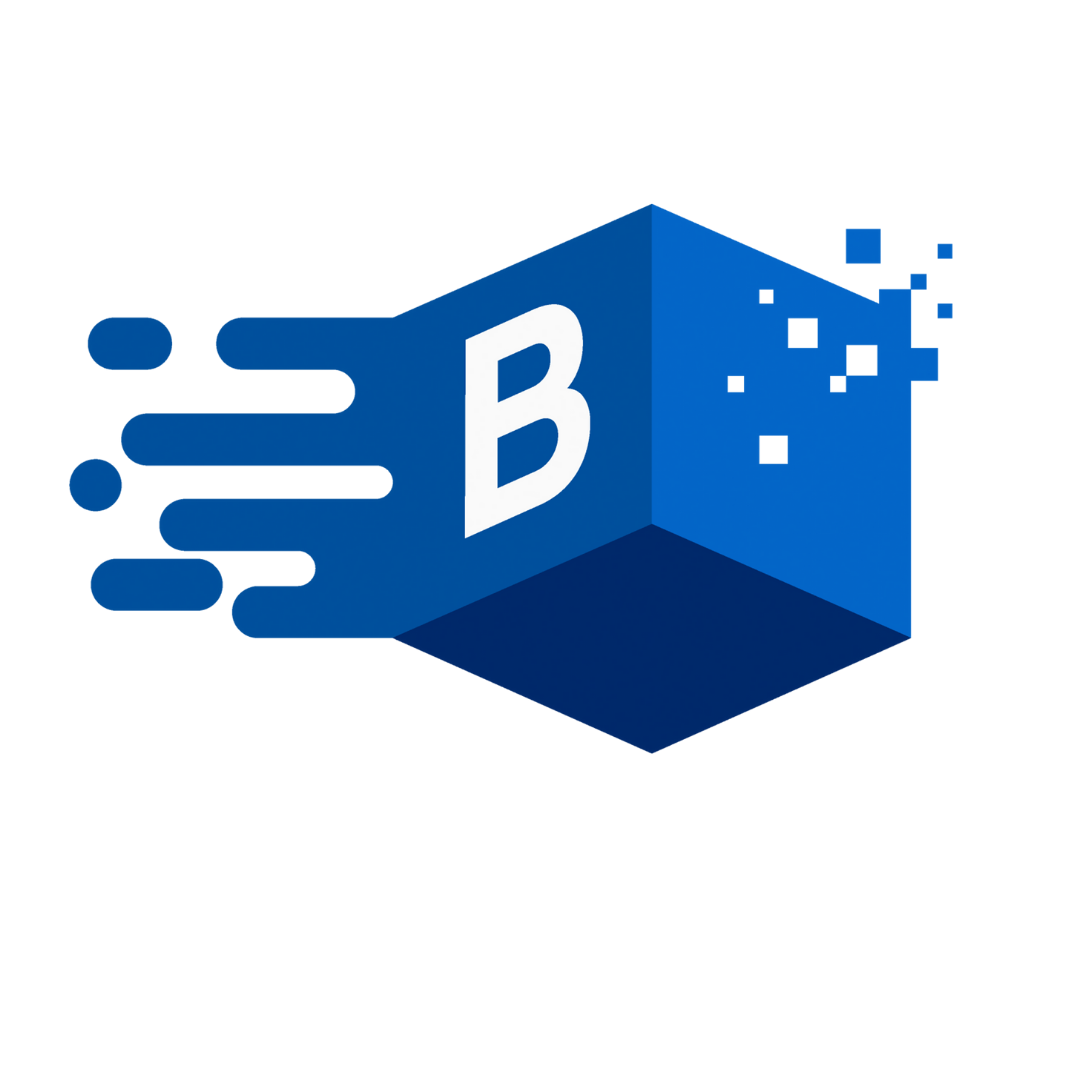 BUKU Marketing
:
Jan 11, 2023 12:30:00 PM
BUKU Marketing
:
Jan 11, 2023 12:30:00 PM

Every year Shopify releases a list of trends and projections for the following year and what can be learned from the previous year. It's called "Commerce Trends 2023: Industry Report". The information is pulled from proprietary data, insider experts, and top global brands. This report is extremely useful and can benefit any eCommerce brand looking to have a fantastic 2023. In this article we will breakdown key takeaways from the report and how you can take the information and apply it to your store today.
Trends and how to take advantage of them
2022 and 2023 can be seen as difficult years of economic transition, and some data points to this. But they can also be beneficial if you’re able to capitalize on the still-growing industry, learn from others, and follow top trends.
Look back at 2022
“Unexpected is the new normal.” This is a statement from Shopify’s report. This could not be more true. There are always things that will impact us that we could have never foreseen. The pandemic is a perfect example of this. First, creating an exponential demand for online goods almost overnight. Which then caused supply chain problems, product shortages, and port traffic. All causing delays. No one could have ever known about the impact of a simple virus at the beginning of 2020. In 2022 we still saw recovery from COVID. Supply chains are working hard to get back on pace, but there was a significant drop in online demand as states and countries began to reopen. As they did, people began shopping more in person. Thus, the pendulum of demand swung from eCommerce back to physical store locations. But eCommerce is still a growing industry and is the future of shopping.
Another unforeseeable event was the war between Ukraine and Russia. This caused a variety of supply and market downturns. Economies suffered, prices surged, and it is likely we will feel the effects of this war for years to come.
“As brands grapple with the challenges in 2023, they'll need to respond by adding flexibility to their products, plans, and policies. With an economic recession on the horizon, being agile has never been more important. This report outlines the global trends equipping brands to confront the unexpected.”
Being flexible when change comes and understanding your problems is critical. Be willing to change how you do business. In this next year, we have no idea what lies ahead. Both positively and negatively. But if you are prepared, willing to change, and intentional with your brand, you will have success.
Projections for 2023
Growth in 2023 is projected to be slow but still significant. Because overall growth is slow, it doesn’t mean there isn’t money to be made or room for individual brands to grow. “While commerce growth is slowing, total retail sales in 2022 have climbed 15% since 2020, and they're projected to reach more than $31 trillion in 2025. But it will be a slow climb.”
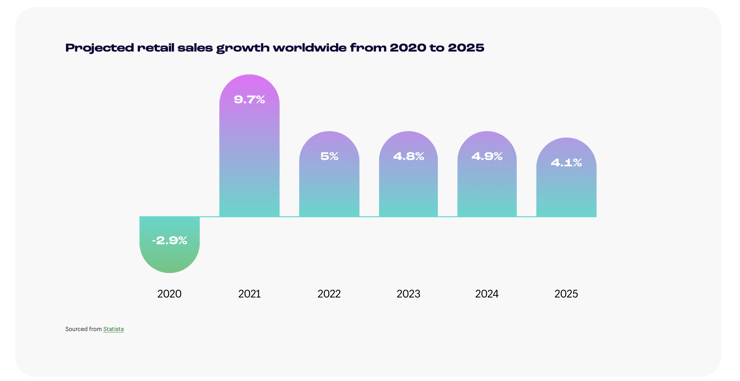
Another thing you need to watch out for in the next year is inflation. We have already seen some of the effects of this in 2022. The effects of inflation are projected to continue through the following years. This increases the cost of doing business for every brand. Supplies, packaging, fuel, shipping, and other factors will all see an increase in price. “Although some say the recession fear is overdone, let’s face it—even the possibility of a recession affects how businesses spend, venture capitalists invest, and people shop.”
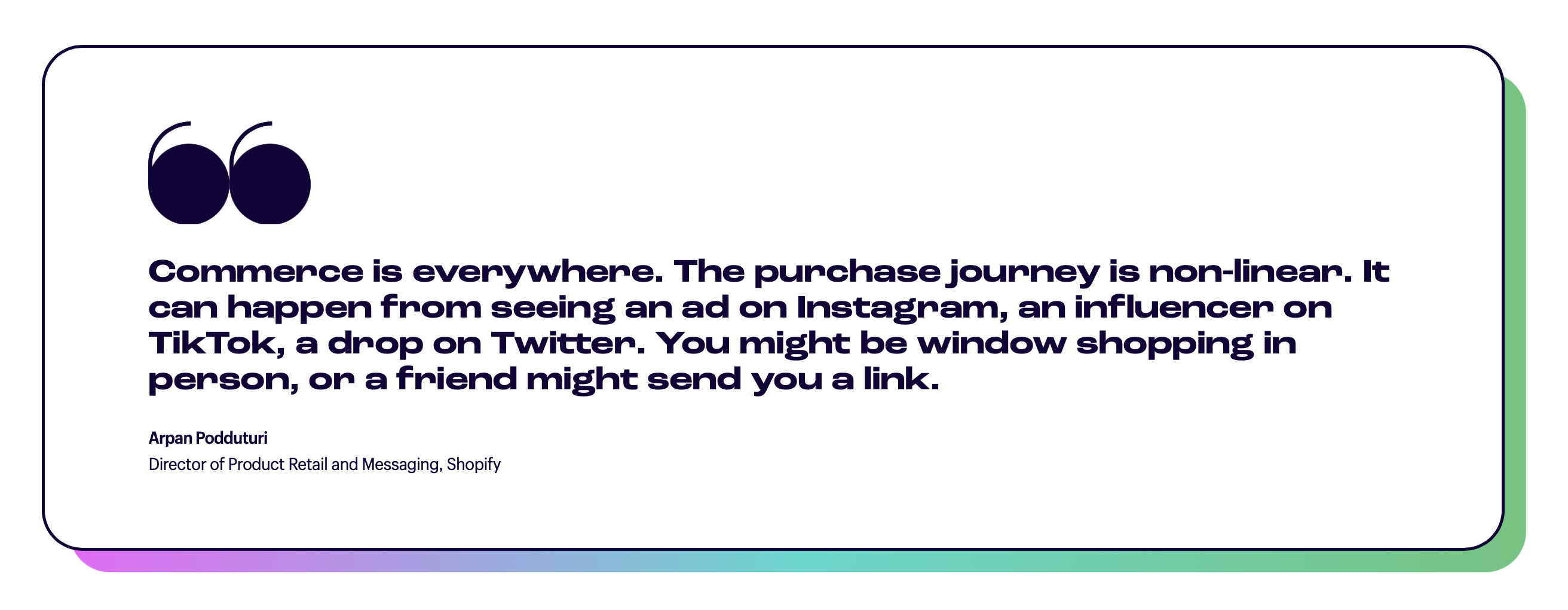
2023 Trends and How to Take Advantage of Them
Slowed growth, inflation, and a possible recession. Sounds like a lot. But there are specific trends and tips that you can use to overcome these potential problems for 2023.
Supply chain
We have seen supply chain issues from the pandemic to the Russia-Ukraine war. These problems are likely here to stay for the next while. Experts had initially predicted that these issues would normalize. But when the war started in 2022, the world had more supply chain issues on its hands.
Another negative of these issues is that consumers still expect the same service as before. Next-day and 2-day shipping options are still the most popular, and consumers expect every brand to offer this.

Thankfully, Shopify has proposed some possible solutions brands can implement during 2023.
This is one of the most common ways that you, as a Shopify store, can make a difference in avoiding supply chain issues. “The world's 3,000 biggest businesses now keep the equivalent of 1% GDP more inventory holdings compared to 2019.”
With more inventory, you’ll be able to satisfy customers’ needs easier. But it is still crucial to manage this inventory correctly. Don’t overstock. There is a certain point when holding extra inventory becomes excessive. “Most buyers have less spending power right now; brands need to watch how many higher priced items they keep on hand. In the second quarter of 2022, the inventory-to-sales ratio spiked for items priced over $100 for some Shopify merchants, probably because shoppers are responding to inflation by choosing cheaper options. So, it's crucial to manage inventory closely.”
Finding new sources for your product can be difficult but can end up making a huge difference for your store. Shopify mentions that it has become commonplace to build “shock absorbers” to combat supply chain problems. “30% have found new suppliers and 29% now get their products from multiple suppliers or countries.”
Also stating that looking to source products or raw materials locally helps with some of the supply chain issues you may face throughout the year.
With an increase in returns you can easily start to lose money from new customers you thought were creating more sales.
Decreasing returns is key to saving money, creating a better customer shipping experience, and avoiding clogs in the supply chain for returns.
The best way to go about minimizing returns is by being as transparent with the customer as possible as well as providing them with ample information regarding the product.
Creating detailed product description and a 360 view of the product are two simple ways to do so. Read our blog to learn more tips about reducing returns
“The more volatile global supply chains are, the faster brands must respond. One-third of the brands we surveyed planned to digitize manual processes within their supply chains. That looks like using scanning apps or inventory management software, or relying on machine learning and artificial intelligence (AI)–based solutions to do everything from load pooling to dynamic rerouting.”
Doing all of these things can help you combat the supply chain struggles that we all will face in 2023. Don’t let outside factors dictate how well your brand does. Apply these tips to make 2023 the best year for your brand and meet all customer expectations!
Money
Want to implement strategies to cut costs during inflation as well as increase customer loyalty? Well that is exactly what is covered in this section.
Inflation and a potential recession have caused buyers to spend less and less often. Fuel and food prices have already seen dramatic increases. What are the stats you might be asking? "The World Trade Organization (WTO) estimated a merchandise trade volume growth of 3.5% in 2022—down from the previous forecast of 4.7%. The WTO expects trade volume growth to drop to 1.0% in 2023, and the economic uncertainty and higher prices are causing buyers to spend less. Over 40% of shoppers switched to lower priced, private-label brands at grocery stores in 2022. According to a survey of global Shopify Plus merchants, 35% have seen shrinking average cart sizes, and 50% are seeing less site traffic and lower conversion rates."
How can I fight these monetary challenges for 2023?
Depending on your brand and the level of customer loyalty you might want to try two different strategies. Brands with loyal customers play with their prices weekly or even daily to cover the cost of inflation.
Other brands, like Old Navy, are doing the opposite to attract more demand. By freezing prices and advertising, they are drawing in high sales. Old Navy's promotions focused on returning to school and getting everything you need within your budget. Trying to ease parents' burdens when paying for things this school year.
"Price freezes are a longer-term investment in customer loyalty, but not every brand is in a position to absorb the cost of inflation on behalf of customers. In fact, 81% of businesses surveyed already have price increases as part of their inflation-response strategy."
Rewarding your loyal customers with discounts can increase brand loyalty and give them a better brand-consumer experience.
"Discounting products via product bundles or time-sensitive sales can be marketed as personalized recommendations to help hard-to-move products move fast."
Implementing this form of business is popular during times of economic instability. Give your customers better value for what they are purchasing. Adding great perks and incentives draws the customers in and creates a reoccurring monthly revenue for you. Programs like this can draw in more customers and increase brand loyalty while helping provide stability for the brand.
By reducing overhead fixed costs, you will be able to operate more freely and save yourself money. As well as come out of recession even more able. "McKinsey reports that the competition for warehouse and fulfillment labor has made automation in warehousing a necessity for sustainable growth. The global workflow automation market will have an estimated compound annual growth rate of 23.4% from 2022 to 2030, reaching $78.8 billion by the end of the decade. Set-it-and-forget-it workflows based on relevant triggers, conditions, and actions simplify processes, reduce the risk of human error, and free up resources."
Marketing
Using collaboration can help brands gain more customers. The loss of cookies and tracking on many web pages makes it harder for brands to target audiences. These challenges will only get more complicated with additional privacy laws being signed each year.
To solve this data issue, brands are turning to 3 solutions.
Brands willing to collaborate and partner with other brands get new eyes on each other's products and expand their possible market audience. Don't shy away from creating partnerships in diverse markets. These new customers, even if not in the same space, could find a need for your products.
"Consumers want to connect with people, not just businesses. Almost one-third of shoppers say influencer recommendations are more important than recommendations from friends and family, and 71% of businesses expect online influencers to become even more important in the future."
As for Gen Z, your best bet is to do short-form market creation. Apps like TikTok, Instagram and Youtube are great spaces for this type of advertisement. The influence that this form of marketing has on this generation is very significant. So when trying to capture a younger market, test out a few of these platforms.
Loyalty programs are getting increasingly popular. But, ensure that the customers, not the transactions, are at the center of these programs. "Brand loyalty takes a hit in times of economic crisis, which is why more loyalty programs show up across industries when spending is down. Six out of 10 companies had loyalty programs to thank for keeping customers engaged during the pandemic."
eCommerce
Post-pandemic, we have seen slowed growth in the eCommerce industry. Still growth, but slowed. And as the years follow, this growth will start to stabilize.
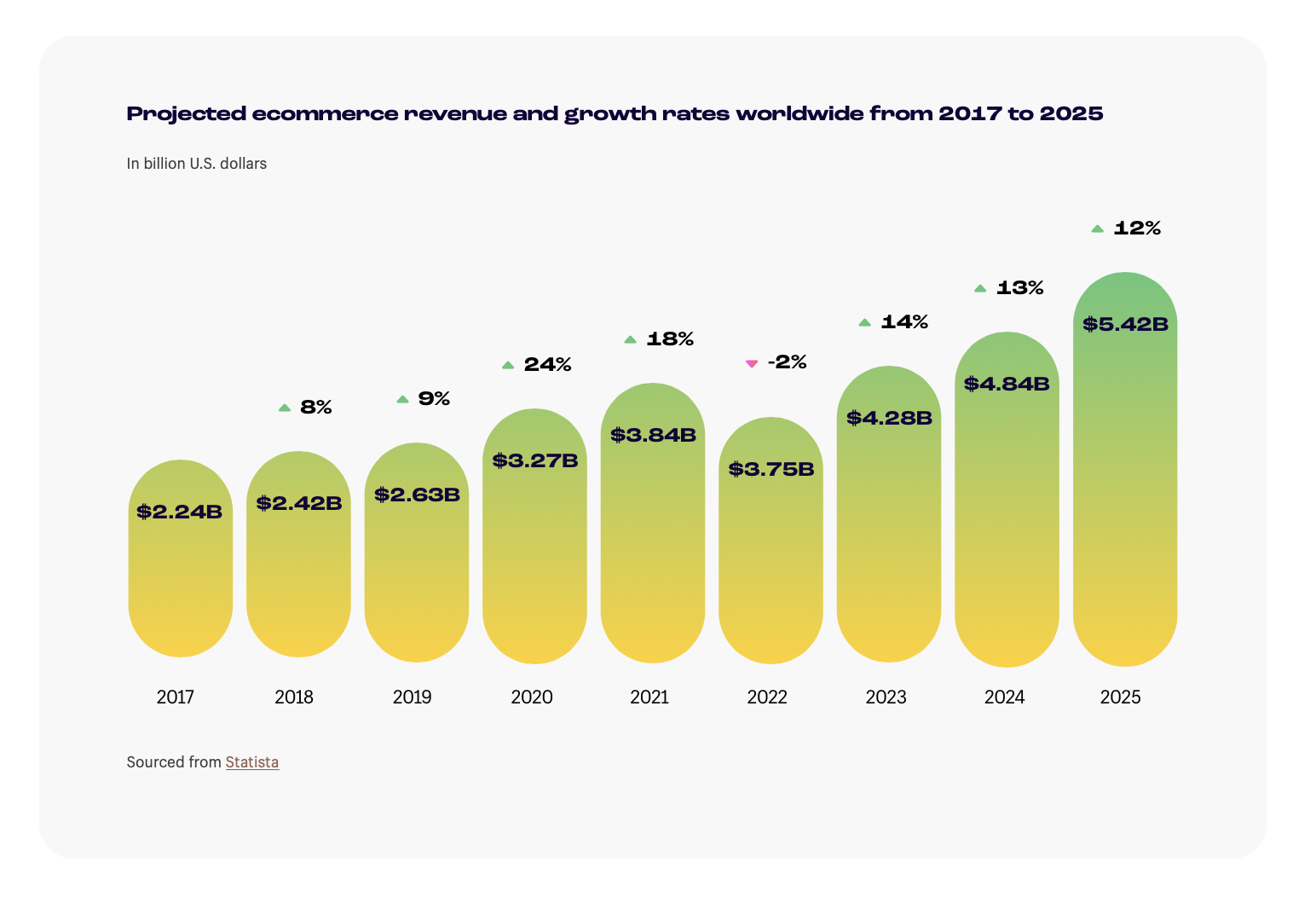
Social media can be a great place for brands to find growth. Competition in the eCommerce industry is high. A great way to differentiate yourself and establish your brand is online, specifically on social media platforms. Social commerce sales are projected to shoot from 990 billion in 2022 to 2,900 billion by 2026. This is huge! Not only will sales increase but so will spending on advertisements on these social platforms.
What are some ways you can take advantage of the eCommerce space?
It is vital for customers to have a medium to contact the brand they are wishing to purchase from. Keeping this process simple and effective will gain your customers' loyalty.
Many growing apps allow you to message your consumers. Apps like: Telegram, WeChat, and WhatsApp business.
If live chat isn't an option, try using chatbots. This is a simple solution to your time constraints.
As a brand you want to decrease the amount of friction that your customers feel when purchasing from you. Adding a buy now button on advertisements is a great example of this. "Shoppable videos lower barriers to conversion even more, with some companies reporting conversion rates near 30%. Although live commerce in China is so big it eclipses almost every national ecommerce market, live shopping has also been gaining momentum in the United States and Europe since 2019. Facebook, Instagram, Pinterest, and TikTok each invested in liveshopping capabilities on their platforms over the pandemic."
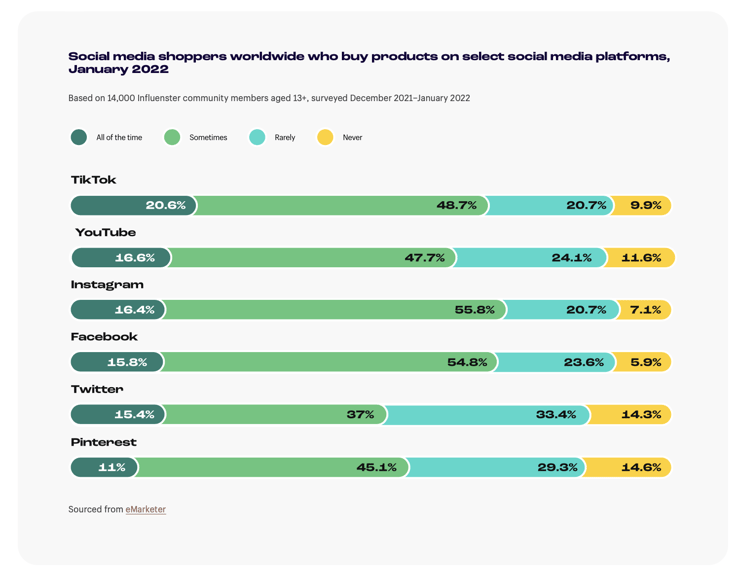
Use these tips to stay afloat during this next year.
Retail
The pandemic has shifted how consumers purchase from retail stores. "Of the businesses we surveyed, 82% are confident physical stores will continue to play an important role in future commerce growth.* In fact, as restrictions around the world loosened in 2021, physical retail grew faster than ecommerce. Even half of Generation Z shoppers, who famously spend more time online than any other age group, favor in-store shopping. And their spending power will only grow—even more than the $360 billion US in their pockets today.
Although foot traffic is up, it's still at least a few percentage points below pre-pandemic levels."
Key points:
"The purpose of retail is evolving. Instead of being the ultimate destination, storefronts are now just one of several stops on a customer's journey.
In-store experiences are trending. Competition is ramping up, so brands are captivating customers with one-of-a-kind, immersive interactions.
Happy employees mean happy customers. Today’s workers need more out of their role if brands want to keep the customer service bar high."
Final takeaways
The final takeaways from Shopify's report are that many factors in 2023 could make the market unstable. From inflation and supply chain issues to a possible recession looming. Thankfully, there are still trends that any brand can follow to help minimize possible losses and transform your brand for 2023. Brands that survive during more difficult times often thrive post recessions. Utilize all of these tips and tricks that Shopify suggests to better your 2023 outcome.
And for any shipping needs, BUKU - The Ecommerce Shipping Customer Experience Platform - is here to save you money and to create the best customer shipping experience possible. Our app IntelliRate is easily downloaded on the Shopify app center. After that, our onboarding process is free and simple!
Some of BUKU's features include:
Want to learn more? Click here to meet with one of our shipping experts.

The supply chain is a term used to describe all the components required to transport goods from beginning to end, from production to the end...

A smart warehouse is a large building where raw materials and other consumer goods are stored using machines, computers, comprehensive software, and...

Direct-to-consumer (DTC) fulfillment is a strategy that helps brands sell and deliver their products directly to customers more efficiently while...